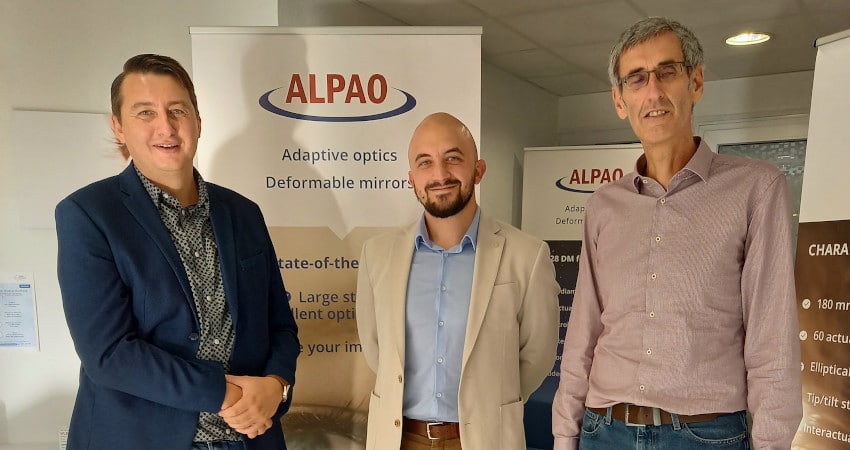In October 2021, ALPAO was honoured to receive Frank Eisenhauer for our collaborative work on Gravity+ Project, with Max Planck Institute for extraterrestrial Physics (Munich, Germany) and Institute for Planetary sciences and Astrophysics (Grenoble, France). During his visit, he answered some questions about adaptive optics, its applications and his work with ALPAO.
ALPAO – How would you explain, sum up in few words adaptive optics to beginners?
Frank Eisenhauer – Let me talk about astronomical adaptive optics, this is where I’m coming from. Here the problem is the turbulence of the Earth’s atmosphere, which blurs our images. With adaptive optics we analyze this blur a thousand times per second, and send according corrections to a deformable mirror, for example from ALPAO. As a result, you restore the full sharpness of the images.
In what context do you use AO?
At the Max Planck Institute for extraterrestrial Physics, we use adaptive optics to take optimum advantage of the world’s largest telescopes. One application is the GRAVITY experiment, for which we combine the light from several telescopes by a technique called interferometry. This technique results in 20 times sharper images than what is possible with a single telescope. And adaptive optics is a prerequisite to do so.
What are the major benefits of AO for your work?
Adaptive optics and interferometry led to a revolution in high angular resolution astronomy. For example, it was key to the discovery of a supermassive Black Hole at the center of our galaxy, for which Reinhard Genzel and Andrea Ghez have been awarded the Nobel Prize in Physics 2020. By using adaptive optics we were able to follow the motion of stars around this otherwise invisible object, measure its mass of more than 4 million times the mass of our Sun, and test the predictions of Einstein’s Theory of General Relativity.
What perspective do you see for AO in the scientific domain?
The next generation of ground-based 30-40m diameter telescopes will fully rely on adaptive optics. But even for space telescopes, which observe above the turbulent Earth atmosphere, AO will ultimately become the technique of choice to push their sharpness to the physical limit, for example to image planets in other solar systems. I can also imagine applications in laser experiments, as well as in gravitational wave detectors.
How long have you been working with ALPAO?
The development of the deformable mirrors for the GRAVITY+ upgrade of the ESO Very Large Telescope Interferometer is my first direct project together with ALPAO. But indirectly, though the joint interferometry effort with the Institute for Planetary sciences and Astrophysics (Grenoble, France) and the European Southern Observatory, we have taken advantage of ALPAO mirrors for many years.
What advantages do you see in ALPAO’s technology?
The deformable mirror technology from ALPAO matches very well the specific needs of GRAVITY+. In our case we need a mirror with a diameter of 100 mm and more than 1000 actuators. The magnetic actuators from ALPAO have the right size and stroke, and the mirror technology can be well tailored to our mirror dimension and speed requirements.
Biography
Frank Eisenhauer is senior staff scientist at the Max Planck Institute for extraterrestrial Physics (near Munich – Germany), where he is leading the development and science exploration of large astronomical instruments and experiments.
Two of them, SINFONI and GRAVITY, are part of the instrument suite employed in the discovery and characterization of the Galactic Center Black Hole, for which Prof. Dr. Reinhard Genzel and Prof. Dr. Andrea Ghez have been awarded the 2020 Nobel Prize in Physics.
In 2021, Eisenhauer was awarded the Tycho Brahe Medal Tycho Brahe Medal from the European Astronomical Socety for his leadership of the SINFONI and GRAVITY instruments.
Read full biography



